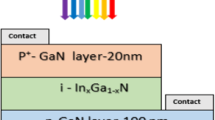Abstract
InGaN has been predicted to be an efficient photovoltaic material. However, the high-density polarization charges and large potential barrier at the i-InGaN/n-GaN interface create an electric field that severely decreases the collection efficiency of p-InGaN/i-InGaN/n-GaN heterostructure solar cells. We demonstrate that, according to numerical simulations, utilizing a p-InGaN/i-InGaN/n-ZnO heterostructure can greatly reduce the piezoelectric field in the absorption layer and reduce the potential barrier between the n-type layer and the absorption layer interface, thus improving the performances of the solar cell. Moreover, we studied the influence of the band alignment on the ZnO/InGaN interface on the performance of the solar cell. We found that the band alignment of the ZnO/InGaN interface can keep the solar cells at a very high efficiency over a wide scope.






Similar content being viewed by others
References
Wu JQ (2009) When group-III nitrides go infrared: new properties and perspectives. J Appl Phys 106(1):011101
Jani O, Ferguson I, Honsberg C et al (2007) Design and characterization of GaN/InGaN solar cells. Appl Phys Lett 91(13):132117
Wu J, Walukiewich W, Yu KM et al (2003) Superior radiation resistance of In1−x Ga x N alloys: a full-solar-spectrum photovoltaic materials system. J Appl Phys 94(10):6477–6482
Nanishi Y, Satio Y, Yamaguchi T (2003) RF-molecular beam epitaxy growth and properties of InN and related alloys. J Appl Phys 42(5A):2549–2559
Vazquez M, Algora C, Rey-Stolle I et al (2007) III-V concentrator solar cell reliability prediction based on quantitative LED reliability data. Prog Photovolt 15(6):477–491
Neufeld CJ, Toledo NG, Cruz SC et al (2008) High quantum efficiency InGaN/GaN solar cells with 2.95 eV band gap. Appl Phys Lett 93(14):143502
**e S, Feng ZH, Liu B et al (2013) DC characteristics of lattice-matched InAlN/AlN/GaN high electron mobility transistors. Trans Tian** Univ 19(1):43–46
Bhuiyan AG, Sugita K, Hashimoto A et al (2012) InGaN solar cells: present state of the art and important challenges. IEEE J Photovolt 2(3):276–293
Abell J, Moustakas TD (2008) The role of dislocations as nonradiative recombination centers in InGaN quantum wells. Appl Phys Lett 92(9):091901
Yu ET, Dang XZ, Asbeck PM et al (1999) Spontaneous and piezoelectric polarization effects in III-V nitride heterostructures. J Vac Sci Technol B 17(4):1742–1749
Chang JY, Kuo YK (2011) Numerical study on the influence of piezoelectric polarization on the performance of p-on-n (0001)-face GaN/InGaN p-i-n solar cells. IEEE Electron Dev Lett 32(7):937–939
Kuo YK, Chang JY, Shih YH (2012) Numerical study of the effects of hetero-interfaces, polarization charges, and step-graded interlayers on the photovoltaic properties of (0001) face GaN/InGaN p-i-n solar cell. IEEE J Quantum Electron 48(3):367–374
**a Y, Brault J, Vennéguès P et al (2014) Growth of Ga- and N-polar GaN layers on O face ZnO substrates by molecular beam epitaxy. J Cryst Growth 388:35–41
Nam SY, Choi YS, Song YH et al (2013) n-ZnO/i-InGaN/p-GaN heterostructure for solar cell application. Phys Status Solidi A 210(10):2214–2218
Namkoong G, Diefeng G, Foe K et al (2011) Hybrid nitride-ZnO solar cells. ECS Trans 41(4):185–189
Inoue S, Katoh M, Kobayashi A et al (2010) Investigation on the conversion efficiency of InGaN solar cells fabricated on GaN and ZnO substrates. Phys Status Solidi RRL 4(3/4):88–90
Pantha BN, Sedhain A, Li J et al (2009) Electrical and optical properties of p-type InGaN. Appl Phys Lett 95(26):261904
Nawaz M, Marstein ES, Hole A (2010) Design analysis of ZnO/cSi heterojunction solar cell. IEEE Photovolt Spec Conf 35:2213–2218
IP KPS (2005) Process development for ZnO-based devices. University of Florida, Gainesville
Lide DR (2004) CRC handbook of chemistry and physics. Chemical Rubber Publishing Company, Boca Raton
Brown GF, Ager JW, Walukiewicz W et al (2010) Finite element simulations of compositionally graded InGaN solar cells. Sol Energy Mater Sol Cells 94(3):478–483
VurgaftmanI Meyer JR, Ram-Mohan LR (2001) Band parameters for III-V compound semiconductors and their alloys. J Appl Phys 89(11):5815–5875
Look DC (2001) Recent advances in ZnO materials and devices. Mater Sci Eng B 80(1/3):383–387
Wagner P, Helbig R (1974) Hall effect and anisotropy and maneuverability of electron in ZnO. J Phys Chem Solids 35(3):327–335 (in German)
Wu J, Walukiewicz W, Yu KM et al (2002) Unusual properties of the fundamental band gap of InN. Appl Phys Lett 80(21):3967–3969
Li N (2005) Simulation and analysis of GaN-based photoelectronic devices. Chinese Academy of Sciences, Bei**g (in Chinese)
Bandic ZZ, Bridger PM, Piquette EC et al (1998) Minority carrier diffusion length and lifetime in GaN. Appl Phys Lett 72(24):3166–3168
Chen F, Cartwright AN, Lu H et al (2005) Temperature dependence of carrier lifetimes in InN. Phys Status Solidi A 202(5):768–772
Fabien CAM, Doolittle WA (2014) Guidelines and limitations for the design of high-efficiency InGaN single-junction solar cells. Sol Energy Mater Sol Cells 130:354–363
Fiorentini V, Bernardini F, Ambacher O (2002) Evidence for nonlinear macroscopic polarization in III–V nitride alloy heterostructures. Appl Phys Lett 80(7):1204–1206
Della Sala F, Di Carlo A, Lugli P et al (1999) Carrier screening and polarization fields in nitride-based heterostructure devices. Phys B 272(1/4):397–401
Silvaco Inc. (2013) ATLAS user’s manual. http://www.silvaco.com. Accessed 02 Oct 2013
Henry CH (1980) Limiting efficiencies of ideal single and multiple energy gap terrestrial solar cells. J Appl Phys 51(8):4494–4500
Acknowledgements
This study was supported by the National Natural Science Foundation of China (Nos. 61564007 and 11364034) and Jiangxi Provincial Sci-Tech Support Plan (No. 20141BBE50035).
Author information
Authors and Affiliations
Corresponding author
Rights and permissions
About this article
Cite this article
Liu, S., Wang, L. & Quan, Z. Role of n-ZnO Layer on the Improvement of Interfacial Properties in ZnO/InGaN p-i-n Solar Cells. Trans. Tian** Univ. 23, 420–426 (2017). https://doi.org/10.1007/s12209-017-0058-x
Received:
Revised:
Accepted:
Published:
Issue Date:
DOI: https://doi.org/10.1007/s12209-017-0058-x




